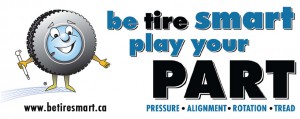
Measuring tire pressures monthly can result in considerable cost savings. A motorist riding on under-inflated tires who drives 20,000 kilometres per year can save at least $100 per year. Those who drive longer distances can save much more.
The environmental benefits of proper tire inflation are also significant. Drivers operating their vehicles on under-inflated tires are expected to waste more than 500 million litres of fuel in 2014, enough to power 275,000 vehicles for a full year. This unnecessary fuel consumption will release an additional 1.2 million tonnes of carbon dioxide into the atmosphere.
On top of all that, properly maintaining your tires will increase their life, presenting an immediate financial savings to you. It is extremely important to rotate your tires regularly to promote even wear at each corner of your car, and check them often to ensure each individual tire is wearing evenly. To maximize your tire life, we at Active Green + Ross Tire Centres recommend checking tire condition and pressure regularly, and there is no better time to start than right now.
“We encourage all motorists to do their ‘PART’ and check vehicle tire Pressure, Alignment, Rotation, and Tread on a regular basis,” says Rich White, executive director, Car Care Council.
“It takes only five minutes to check tire inflation, including the spare. Since tires affect a vehicle’s ride, handling and traction, checking tire pressure frequently and having tires rotated and balanced are an important part of vehicle safety,” explains White.
Here’s how you can do your “PART”:
Pressure – Correct tire pressure is good to your wallet and the environment as properly inflated tires can improve gas mileage by three percent or ten cents per gallon. Underinflated tires are under stress and wear uneven, causing them to be replaced sooner.
Alignment – If your car is shaking or pulling to one side it could be a sign of an alignment issue. Because uneven or accelerated tire wear may indicate an alignment problem, it’s a good idea to have your car’s alignment checked at least once a year.
Rotation – Unless your car manual has a specific recommendation, the Car Care Council recommends having tires rotated every 10,000 km to promote uniform tire wear. Unbalanced wheels can cause rapid wear of shock absorbers and struts, and wheel balance can change as a result of normal tire wear. Rotating the tires to keep their sizes equal is critical on full-size four-wheel drive vehicles as a difference of only 6 mm between the outside circumference of the front and rear tires can cause expensive damage. Replacing all four tires at the same time, rather than just the front or rear tires, is highly recommended for these vehicles.
Tread – Use the penny test and visually inspect tires for sign of uneven wear. place a penny in the tire’s groove with the Queen’s crown facing down. If you can see the top of the Queen’s crown, the tire needs replacing. If the tread depth falls below the minimum legal requirement or the sidewalls become severely cracked or punctured, tire replacement will be necessary.
Each year, the Rubber Association of Canada (RAC), promotes “Be Tire Smart” week, during the middle of May in Canada, while the American Rubber Manufacturers Association promotes its Tire Safety Week during first week of June in the United States.
The Canadian Car Care Council is the source of information for the “Be Car Care Aware” consumer education campaign promoting the benefits of regular vehicle care, maintenance and repair to consumers. For more information on service interval schedules, questions to ask a technician and tips to drive smart and save money, please contact us.
